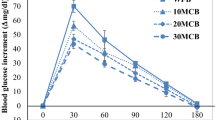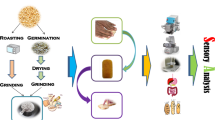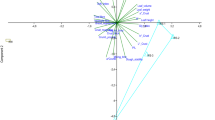Abstract
Whole grain flours (e.g., barley, brown rice, buckwheat, whole wheat) were characterized and their effects on the retardation of starch digestion in pastes and cakes were examined. Buckwheat flour had the highest dietary fiber, the lowest starch, and lowered paste viscosities than all other flours. Under in vitro starch digestion, buckwheat and whole wheat flours were highly effective at lowering starch hydrolysis in pastes and cakes. Furthermore, replacing wheat flour with 50% buckwheat or whole wheat flours maintained the volume index and textural properties of cakes. Therefore, substituting up to 50% of whole grain flour for wheat flour in cake formulation produces acceptable quality as well as health benefits (lower predicted glycemic index and increased nutritional value).
Similar content being viewed by others
References
Hwang CK, Han PV, Zabetian A, Ali MK, Narayan KMV. Rural diabetes prevalence quintuples over twenty-five years in low- and middle-income countries: A systematic review and meta-analysis. Diabetes Res. Clin. Prac. 96: 271–285 (2012)
International Diabetes Federation. IDF Diabetes Atlas. Available from: http://idf.org/diabetesatlas.
Slavin J. Whole grains and human health. Nutr. Res. Rev. 17: 99–110 (2003)
Hung PV, Maeda T, Morita N. Dough and bread qualities of flours with hole waxy wheat flour substitution. Food Res. Int. 40: 273–279 (2007)
Jenkins DJ, Wolever TM, Jenkins AL, Giordano C, Giudici S, Thompson LU, Kalmusky J, Josse RG, Wong GS. Low glycemic response to traditionally processed wheat and rye products: bulgur and pumpernickel bread. Am. J. Clin. Nutr. 43: 516–520 (1986)
Rodrígues R, Jiménez A, Fernándes-Bolaños J, Guillén R, Heredia A. Dietary fibre from vegetable products as source of functional ingredients. Trends Food Sci. Technol. 17: 3–15 (2006)
Chillo S, Ranawana DV, Henry CJK. Effect of two barley β-glucan concentrates on in vitro glycaemic impact and cooking quality of spaghetti. LWT-Food Sci. Technol. 44: 940–948 (2011)
Wang J, Rosell CM, de Barber CB. Effect of the addition of different fibres on wheat dough performance and bread quality. Food Chem. 79: 221–226 (2002)
Gularte MA, de La Hera E, Gómez M, Rosell CM. Effect of different fibers on batter and gluten-free layer cake properties. LWTFood Sci. Technol. 48: 209–214 (2012)
Choo CL, Aziz NAA. Effects of banana flour and β-glucan on the nutritional and sensory evaluation of noodles. Food Chem. 119: 34–40 (2010)
Yousif A, Nhepera D, Johnson S. Influence of sorghum flour addition on flat bread in vitro starch digestibility, antioxidant capacity and consumer acceptability. Food Chem. 134: 880–887 (2012)
AOAC. Official methods of analysis of AOAC international. 17th ed. AOAC International, Gaithersburg, MD, USA (2000)
Hovenkamp-Hermelink JHM, de Vries JN, Adamse P, Jacobsen E, Witholt B, Feenstra WJ. Rapid estimation of the amylose/ amylopectin ratio in small amounts of tuber and leaf tissue of the potato. Potato. Res. 31: 241–246 (1988)
Prosky L, Asp NG, Schweizer T, de Vries J, Furda I. Determination of insoluble, soluble, and total dietary fiber in foods and food products: interlaboratory study. J. Assoc. Off. Anal. Chem. 71: 1017–1023 (1988)
Miller DD, Schricker BR, Rasmussen RR, van Campen D. An in vitro method for estimation of iron availability from meals. Am. J. Clin. Nutr. 34: 2248–2256 (1981)
Mainville I, Arcand Y, Farnworth ER. A dynamic model that simulates the human upper gastrointestinal tract for the study of probiotics. Int. J. Food Microbiol. 99: 287–296 (2005)
Goñi I, Garcia-Alonso A, Saura-Calixto F. A starch hydrolysis procedure to estimate glycemic index. Nutr. Res. 17: 427–437 (1997)
AACC. Approved methods of American Association of Cereal Chemists. 10th ed. American Association of Cereal Chemists, St. Paul, MN, USA (2000)
Giuberti G, Gallo A, Cerioli C, Masoero F. In vitro starch digestion and predicted glycemic index of cereal grains commonly utilized in pig nutrition. Anim. Feed. Sci. Technol. 174: 163–173 (2012)
Angioloni A, Collar C. Physicochemical and nutritional properties of reduced-caloric density high-fibre breads. LWT-Food Sci. Technol. 44: 747–758 (2011)
Englyst KN, Vinory S, Englyst HN, Lang V. Glycaemic index of cereal products explained by their content of rapidly and slowly available glucose. Brit. J. Nutr. 89: 329–339 (2003)
Zangh G, Ao Z, Hamaker BR. Slow digestion property of native cereal starches. Biomacromolecules 7: 3252–3258 (2006)
Chung HJ, Liu Q, Pauls PK, Fan MZ, Yada R. In vitro starch digestibility, expected glycaemic index and some physicochemical properties of starch and flour from common bean (Phaseolus vulgaris L.) varieties grown in Canada. Food Res. Int. 41: 869–875 (2008)
Karaoglu MM, Kotancilar HG. Quality and textural behaviour of par-baked and rebaked cake during prolonged storage. Int. J. Food Sci. Technol. 44: 93–99 (2009)
Kim J, Lee SM, Bae IY, Park HG, Lee HG, Lee S. (1→3)(1→6)-β-Glucan-enriched materials from Lentinus edodes mushroom as a high-fibre and low-calorie flour substitute for baked foods. J. Sci. Food Agr. 91: 1915–1919 (2011)
Masoodi FA, Sharma B, Chauhan GS. Use of apple pomace as a source of dietary fiber in cakes. Plant Food. Hum. Nutr. 57: 121–128 (2002)
Author information
Authors and Affiliations
Corresponding author
Rights and permissions
About this article
Cite this article
Bae, I.Y., Lee, H.I., Ko, A. et al. Substituting whole grain flour for wheat flour: Impact on cake quality and glycemic index. Food Sci Biotechnol 22, 1–7 (2013). https://doi.org/10.1007/s10068-013-0216-4
Received:
Revised:
Accepted:
Published:
Issue Date:
DOI: https://doi.org/10.1007/s10068-013-0216-4




